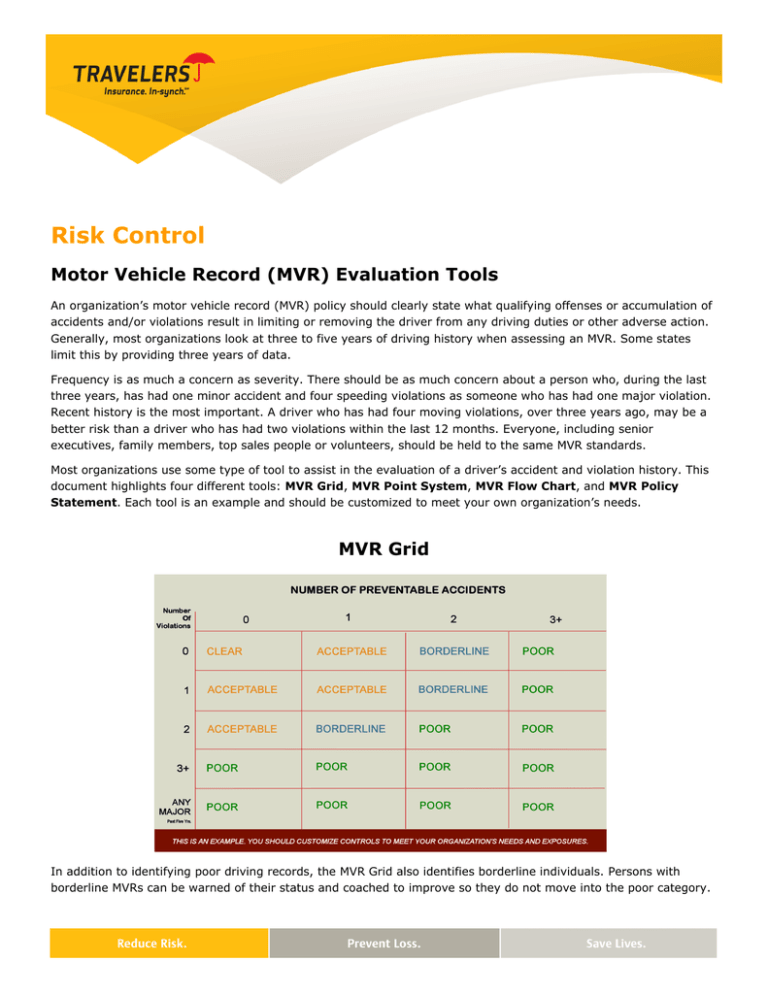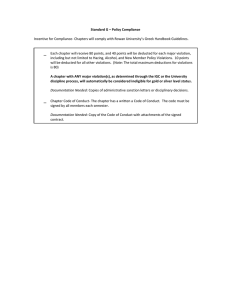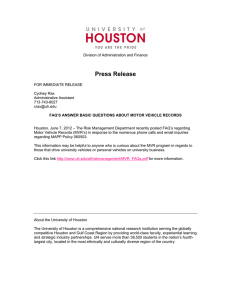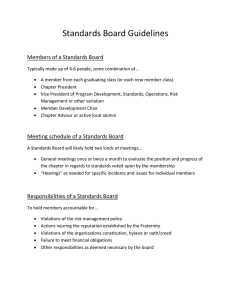
Risk Control
Motor Vehicle Record (MVR) Evaluation Tools
An organization’s motor vehicle record (MVR) policy should clearly state what qualifying offenses or accumulation of
accidents and/or violations result in limiting or removing the driver from any driving duties or other adverse action.
Generally, most organizations look at three to five years of driving history when assessing an MVR. Some states
limit this by providing three years of data.
Frequency is as much a concern as severity. There should be as much concern about a person who, during the last
three years, has had one minor accident and four speeding violations as someone who has had one major violation.
Recent history is the most important. A driver who has had four moving violations, over three years ago, may be a
better risk than a driver who has had two violations within the last 12 months. Everyone, including senior
executives, family members, top sales people or volunteers, should be held to the same MVR standards.
Most organizations use some type of tool to assist in the evaluation of a driver’s accident and violation history. This
document highlights four different tools: MVR Grid, MVR Point System, MVR Flow Chart, and MVR Policy
Statement. Each tool is an example and should be customized to meet your own organization’s needs.
MVR Grid
In addition to identifying poor driving records, the MVR Grid also identifies borderline individuals. Persons with
borderline MVRs can be warned of their status and coached to improve so they do not move into the poor category.
Page 2
Risk Control
MVR Point System
The MVR Point System also does a good job of graduating drivers so that borderline individuals can be warned of
their status and coached to improve. The Violation/Accident Guidelines and Points Columns on the right are
used to assign points to each accident or violation over a three-year period. The points are then totaled to establish
the Profile Points in the left column. For example, if a driver has a violation for talking on a cell phone (2 points)
and a violation for speeding 15 miles over the speed limit (3 points) she would have 5 total points which would
place her in the minor risk category.
The Corrective Action Guidelines column offers suggestions for corresponding profile risk points.
It is important to develop your own point system and not use the points assigned on MVRs by the state. Several
states do not assign points, and those that do have differing point systems, which could result in employees from
different states being treated differently based on the same violations.
Page 3
Risk Control
MVR Flow Chart
The MVR Flow Chart has similar criteria as the grid and point system; however, there are no graduations, simply
a “yes-no” status.
MVR Policy Statement
Safe driving record during the past three years, including:
y
No serious/major moving violations.
y
No more than three minor moving violations.
y
No drug- or alcohol-related offenses.
y
No major preventable accidents or multiple minor preventable accidents.
y
No more than three minor violations or minor accidents combined.
y
No more than three minor violations or minor accidents combined.
Similar to the flow chart, the MVR Policy Statement has no graduations, simply a “yes-no” status.
Page 4
Risk Control
Violation Types
Examples of Major Violations:
y
y
y
y
y
y
y
y
y
Leaving the scene of an accident
Driving under the influence of drugs or alcohol
Racing or excessive speed (>20 MPH over speed limit)
Reckless, negligent or careless driving
Felony, homicide or manslaughter involving the use of a motor vehicle
License suspension or revocation resulting from accidents or moving violations
Following too closely or tailgating
Erratic lane-changing
Attempting to elude a police officer
Examples of Minor Violations:
y
y
y
y
Speeding < 20 MPH
Failure to obey sign
Failure to yield
Illegal turn
Examples of Non-Moving* Violations:
y
y
y
Parking tickets
Motor vehicle equipment violations
Failure to have a valid operator's license available where one actually exists
*Non-moving violations are typically not included when evaluating MVRs
For more information, visit our Web site at travelers.com/riskcontrol, contact your Risk
Control consultant or email Ask-Risk-Control@travelers.com.
.....................................................
The Travelers Indemnity Company
and its property casualty affiliates
One Tower Square
Hartford, CT 06183
travelers.com
The information provided in this document is intended for use as a guideline and is not
intended as, nor does it constitute, legal or professional advice. Travelers does not warrant
that adherence to, or compliance with, any recommendations, best practices, checklists, or
guidelines will result in a particular outcome. In no event will Travelers or any of its
subsidiaries or affiliates be liable in tort or in contract to anyone who has access to or uses
this information. Travelers does not warrant that the information in this document
constitutes a complete and finite list of each and every item or procedure related to the
topics or issues referenced herein. Furthermore, federal, state or local laws, regulations,
standards or codes may change from time to time and the reader should always refer to the
most current requirements. This material does not amend, or otherwise affect, the provisions
or coverages of any insurance policy or bond issued by Travelers, nor is it a representation
that coverage does or does not exist for any particular claim or loss under any such policy or
bond. Coverage depends on the facts and circumstances involved in the claim or loss, all
applicable policy or bond provisions, and any applicable law.
© 2008 The Travelers Companies, Inc. All rights reserved.
Doc#: 789





